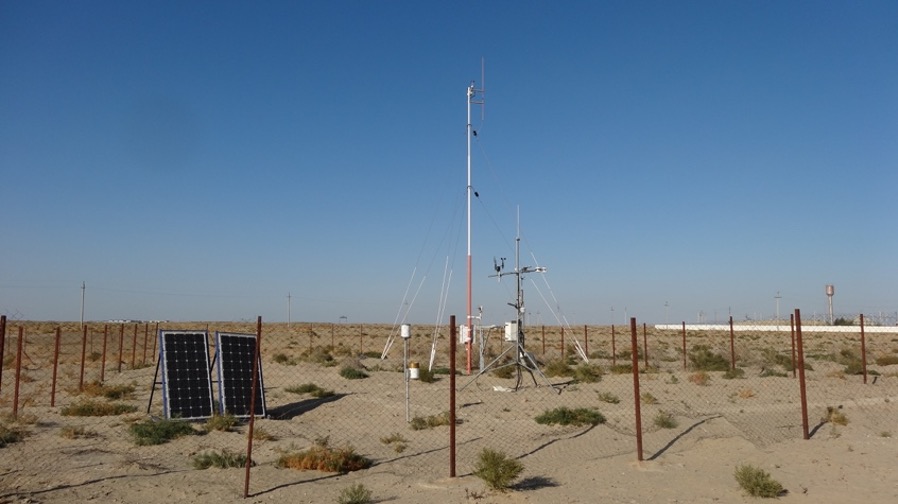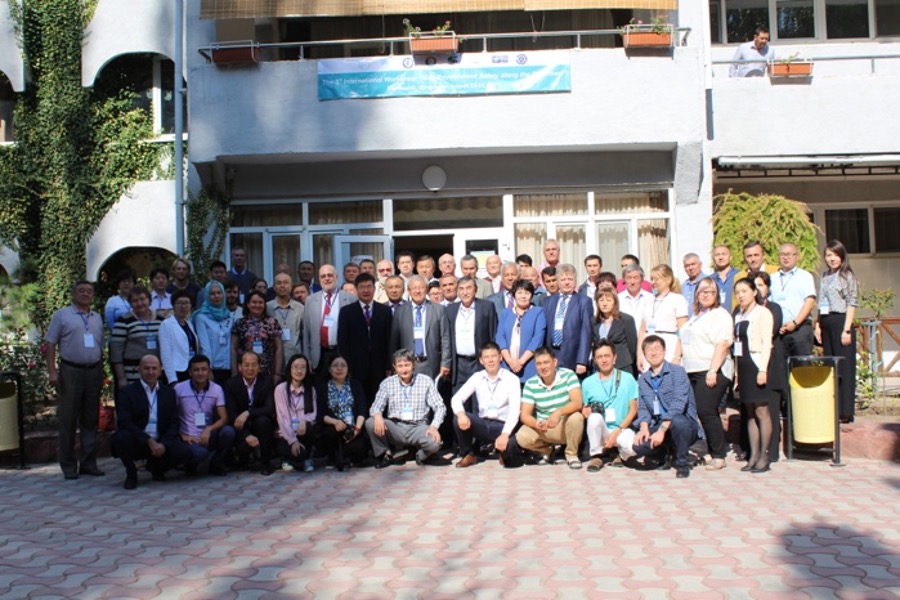 Integrated Disaster Risk Reduction and Climate Change Adaptation in Central Asia
Reduce Disaster Risks, Promote Country Resilience
Integrated Disaster Risk Reduction and Climate Change Adaptation in Central Asia
Reduce Disaster Risks, Promote Country Resilience

Challenges
The hinterland of Eurasia experiences a typical arid climate and accounts for one third of the world’s arid zones. This arid region is prone to a range of disasters, particularly flooding, earthquakes, landslides, drought and desertification. According to statistics released by the United Nations Economic and Social Commission for Asia and the Pacific in 2012, there were 16 earthquakes in Central Asia in the previous decade, with economic losses totalling US$24 million. Floods impacted 19 percent of the population and caused an average of $50.1 million in economic losses annually. Climatological disasters, including drought and desertification, impacted 7.2 percent of the population and caused $107 million in economic losses.
Towards a Solution
China is highly effective in responding to climate change and natural disasters, including desertification, flooding and landslides. Significant efforts have been made to establish mechanisms for disaster risk reduction (DRR) and climate change adaptation (CCA) in disaster-prone areas. Since 2011, the United Nations Development Programme (UNDP) has been implementing climate change adaptation projects that aim to strengthen the institutional capacity and resilience of local communities that are vulnerable to climate risks.
Located in East Eurasia and bordering five Central Asian countries, the Xinjiang Uyghur autonomous region has the largest area of dry land in China and experiences similar climate conditions. As the core of the Silk Road Economic Belt, the government of Xinjiang has established a close partnership and fruitful cooperation on scientific research with colleges and institutions in Central Asian States.
In order to strengthen regional international cooperation and share knowledge and experience in disaster risk reduction, a comprehensive mechanism is needed to promote knowledge-sharing between China and adjacent Central Asian States. The goal of this project is to raise public awareness of disaster prevention, strengthen the disaster risk reduction capacity of Central Asian States and improve capacities to respond to climate change and natural disasters. Drawing from the experiences and techniques acquired by China in previous decades, this project aimed to provide a model to guide construction in the Silk Road Economic Belt and sustainable development in Central Asia.
As the project manager, the Xinjiang Institute of Ecology and Geography (XIEG) was responsible for project operations and provided technical support in implementing and developing project activities. The Research Center for Ecology and Environment of Central Asia (RCEECA) acted as a collaborative partner and was responsible for implementing specific project activities. As the government representative, the China International Center for Economic and Technical Exchanges (CICETE) worked with UNDP to monitor project implementation and ensure overall project oversight and quality assurance.
With regard to the methodology applied, the following steps were taken:
- A platform was established, creating sub-centres for DRR/CCA research, ecosystem field observation sites and a research network, as well as information sub-centres to strengthen capacity for DRR and CCA.
- Technical pilot demonstration sites were established to promote community-based DRR technology and facilitate knowledge-sharing in local communities.
- Historical information was collected and a disaster database was created for flooding and drought in Central Asia.
- A risk map was developed for flooding and drought in Central Asia and a disaster risk assessment report was drafted for Lake Sarez.
- Technical training and capacity-building were carried out through workshops, field visits, policy dialogue and other exchange initiatives to shape DRR/CCA policies.
The project has achieved the following results:
- Three RCEECA sub-centres were established in Almaty, Bishkek and Dushanbe. Each sub-centre comprises of an information sub-centre, joint laboratory, field observation, research station and demonstration base for agricultural technology. These sub-centres serve as an important platform for scientific, technological and educational cooperation between China and Central Asian States. They play an active role in promoting cooperation and personnel training in the fields of ecological and environmental protection, the sustainable use of resources, agricultural development, mineral resource exploration, disaster monitoring and early warning systems.
- Twelve ecosystem field observation and research stations for glaciers, mountains, woodlands, grasslands, farmlands, wetlands and deserts were set up along the Altai Mountains, the Tianshan north slope, the Tianshan south slope and the Pamir Mountains in order to observe and evaluate the ecosystem’s response to climate change in the Central Asian arid region.
- Five pilot demonstration sites were upgraded or established in Central Asian States. They focused on agricultural water saving and saline soil improvement in Kazakhstan, agricultural water saving in Uzbekistan, high-production agriculture in Tajikistan, facility agriculture in Kyrgyzstan and safe drinking water in Kyrgyzstan.
- Paper records from Central Asian States were collected, translated professionally, registered and digitized to create a preliminary database of disasters and historical information on flooding and drought in Central Asia.
- A risk map was developed for flooding in Kyrgyzstan and Tajikistan and drought in Kazakhstan.
- A comprehensive analysis of dam safety and flood prevention and control was undertaken using high-precision drone data from the Usoy Dam in Lake Sarez in combination with historical data on earthquakes, geology and hydrology. The report was prepared and submitted to the President of Tajikistan and the Secretary-General of the United Nations.
- Approximately nine DRR technical trainings, four trainings on drones and remote sensing technology, and one training on writing scientific papers were carried out.
- Over 10 international seminars and workshops, as well as a high-level forum, were organized successfully. There were over 7,500 participants from over 40 countries who shared knowledge and exchanged experiences.
Phases I and II of the project are easily replicable and have been successfully completed, due to the support of RCEECA, XIEG, CICETE, UNDP China and other academic institutions from Kazakhstan, Kyrgyzstan, Tajikistan and Uzbekistan. The project’s cooperation modality and activities could be replicated in other developing countries in future projects, so long as the country has relevant needs that are consistent with the goals and results of this project. The Government and local scientific research institutions must also by willing to participate and provide support. In addition, the technology and achievements of this project must apply to local conditions, and there must be sufficient funds and human resources to support the project’s implementation.
Contact Information
Countries involved
Supported by
Implementing Entities
Project Status
Project Period
URL of the practice
Primary SDG
Primary SDG Targets
Secondary SDGs
Secondary SDG Targets
Similar Solutions
| NAME OF SOLUTION | Countries | SDG | Project Status | |
|---|---|---|---|---|
A Billion Brains: Smarter Children, Healthier Economies High Level Meeting on South-South Cooperation for Child Rights |
China, Kazakhstan, Kyrgyzstan, Tajikistan, Uzbekistan | 17 - Partnerships for the Goals | Completed | View Details |
Accessibility of Financial Services and the Private Sector in Africa Maximizing the impact of financial cooperation on economic development and industrialization in Africa |
China, Kazakhstan, Kyrgyzstan, Tajikistan, Uzbekistan | 08 - Decent Work and Economic Growth | Completed | View Details |
ACP Business-friendly Supporting business-friendly and inclusive national and regional policies, and strengthening productive capabilities and value chains |
China, Kazakhstan, Kyrgyzstan, Tajikistan, Uzbekistan | 08 - Decent Work and Economic Growth 17 - Partnerships for the Goals | Ongoing | View Details |
Addressing the Philippine Dairy Sector Challenges Exchanging knowledge between Argentina and the Philippines to improve Philippine local dairy production |
China, Kazakhstan, Kyrgyzstan, Tajikistan, Uzbekistan | 08 - Decent Work and Economic Growth 17 - Partnerships for the Goals | Ongoing | View Details |
Addressing the Transboundary Dimensions of the 2030 Agenda through Regional Economic Cooperation and Integration in Asia and the Pacific Promoting co-deployment of ICT and transport infrastructure corridors in Central Asia region |
China, Kazakhstan, Kyrgyzstan, Tajikistan, Uzbekistan | 09 - Industry, Innovation and Infrastructure 13 - Climate Action 17 - Partnerships for the Goals | Completed | View Details |


